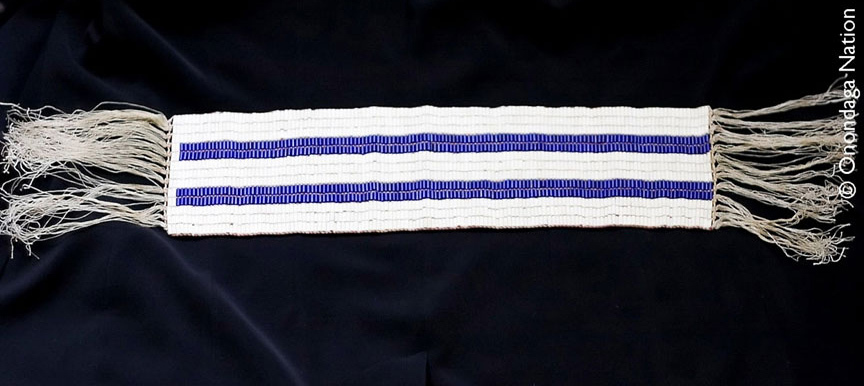Pre-Modern Era
Features, Production and Significance
Subject: Two Row Wampum- It has a white background with two parallel purple lines running through it. It was traditionally given to recipients as a symbol of friendship and unity (Muller, 129). The white part of the wampum was made using whelk shells, while the purple lines were crafted from quahog shells (Muller, 135). Additionally, the Two Row Wampum represents the autonomy of each nation involved, emphasizing mutual respect and independence (Muller, 140).
Wampum is a small, short, tubular bead made from the quahog clam shell. The white beads are made from the inner whorl of the shell, and the purple beads come from the dark spot or "eye" on the shell. They’re produced using wampum beads as nodes representing various topics, while sinew, hemp, tree bark twine, or other stringing devices serve as links connecting associated information. These belts employed architectural mnemonic associations, encoding information through bead placement, proximity, balance, and color (Haas, 78).
Wampum belts served as a crucial form of communication among Native American tribes. They facilitated diplomatic relations by necessitating reciprocity from the recipient, who accepted the implied message and responsibility upon receiving wampum. These belts are maintained through community memory and performance, requiring regular re-reading to preserve their messages. Wampum acts as a living rhetoric, embodying mutual relationships between parties, even when one fails to uphold their promises, as often occurred with colonists. The belts extend human memories of inherited knowledge through their interconnected, nonlinear designs and associative message storage and retrieval methods, making them a sophisticated tool for preserving and communicating cultural memory and agreements (Haas, 81).
Circulation:
According to Tehanetorens, Coastal Indians were the first to make and use wampum, but through trade with other tribes, it traveled to the interior and western regions of the continent. Post-contact, wampum was also appropriated by American colonists, who used it as their first form of currency in colonial "America." Furthermore, the wampum of the Iroquois Confederacy influence the democratic thought that led to the Constitution of the United States (Haas, 80). This highlights how much modern American civilization, literature, politics, and more are built on the culture and traditions of Native people, for which they do not receive credit.
To retrieve the encoded messages, an individual needed to be part of the cultural community that understood the context. The messages embedded in the wampum were spoken and woven into the material, and these messages were repeated each time someone presented the wampum to the community (Haas, 87).
Connection/ Similarities to the Other Eras
Just as Wampum belts used colors to communicate with the recipient, colors in Western visual design evoke specific moods, guiding the "reader" in organizing and interpreting the woven story. This concept is reflected in the publishing of Tommy Orange’s There, There. The book's title is in yellow, a color significant in the story, particularly for Orvil Red Feather, who wears a yellow regalia. This shows how the importance of color in the printing press has maintained importance even after centuries.
In Tommy Orange's novel There There, the printing of his book represents a modern form of preserving and disseminating cultural narratives, much like the wampum belts of the past. Both the wampum belts and the printing press serve as means of communication. Just as the wampum belts circulated knowledge and agreements among Native communities, the printing press in There There disseminated stories and histories, ensuring the preservation and continuity of cultural memory. This idea of printing press being a tool of cultural preservation is reflected in There There, with one of the main characters creating a film (digital print press) to keep Native stories alive, "Dene convinced Blue to let Calvin do his interview for the storytelling project during work hours" (Orange, 148).
